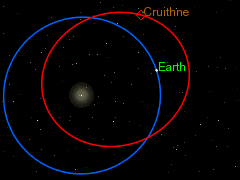Ever heard of 3753 Cruithne?
I hadn't, which is surprising considering my obsession with astronomy. It's an asteroid which is in a 1:1 orbital resonance with Earth -- in simpler terms, it is co-orbital. It's sometimes been called "Earth's second moon," which is inaccurate because it doesn't orbit the Earth; in fact, its actual orbit is highly elliptical. At its perigee, 3753 Cruithne is near the orbit of Mercury, and is outside the orbit of Mars at its apogee.
[Nota bene: the name "Cruithne" is from Gaelic, and because of the strange letter-to-phoneme correspondence in the Gaelic language, is pronounced "kroo-in-ya." It's the name of an obscure king of the ancient Picts; its discoverer, astronomer Duncan Waldron, is Scottish, which probably explains the choice.]
Orbital resonance is one restricted solution to the more general three-body problem, which has yet to be solved by physicists. The orbital interactions between two objects is thoroughly understood; add a third, and suddenly the math kind of blows up in your face. You can run computer simulations starting with three objects of specific masses and velocities and see what happens, but a general set of equations governing any three (or more) body system has proven to be impossibly complex. It's known that a few starting points generate stable orbits (resonance being one of those), and lots more of them prove unstable and eventually result in the objects colliding or flying apart, but trying to come up with the overarching mathematical scheme is currently out of reach.
3753 Cruithne's orbit, at least from our vantage point here on Earth, is a strange one. If you were out in space, looking down on the Solar System, it wouldn't seem odd; an ellipse, tilted at a little less than twenty degrees away from the orbital plane of Earth:
But because of the weird perspective of being in a non-inertial (accelerated) reference frame, what we see on Earth is quite different. As we watch 3753 Cruithne, it appears to be traveling in a bean-shaped orbit, first approaching us and then backing away as if we'd said something inappropriate:
Makes me realize how hard it is to come up with any reasonable model of moving objects in non-inertial reference frames. Looking at 3753 Cruithne's strange wanderings almost leaves me sympathetic with Ptolemy and his nested epicycles. (Isaac Newton, who understood the problem better than just about anyone else, wasn't nearly so forgiving, and called Ptolemy "an outrageous fraud.")
Its orbit classifies it as an Aten asteroid, a group of asteroids whose orbits cross that of the Earth. For those of you who are of an apocalyptic bent, however, no need to lose sleep over 3753 Cruithne; its orbital tilt makes it no threat. Its position has been run forward by computer models for thousands of years, and it has a zero chance of striking Earth.
That's assuming the orbital resonance remains stable, of course, and there's no guarantee it will. There are other players in this gravitational game of pinball besides the Earth and the Sun; Venus and Mercury also come close to 3753 Cruithne on occasion, and a near pass could give the asteroid enough of a gravitational tug to destroy the resonance and destabilize the orbit. The great likelihood if this happens, though, is it falling into the Sun or being flung out of the Solar System entirely; the chance of some gravitational slingshot effect propelling it into the Earth is about as close to zero as you can calculate.
So that's today's astronomical oddity that I, at least, had never heard of. An asteroid in an ongoing celestial dance with the Earth. Just goes to show that to find strange new stuff out in space, you don't need to peer out at the far reaches of the universe -- there's enough right here near home to keep the astronomers busy for a long while.
****************************************













